
A | B | C | D | E | F | G | H | CH | I | J | K | L | M | N | O | P | Q | R | S | T | U | V | W | X | Y | Z | 0 | 1 | 2 | 3 | 4 | 5 | 6 | 7 | 8 | 9

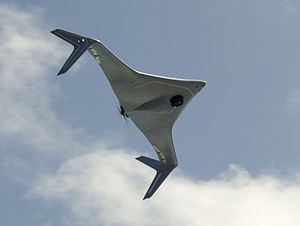



An uncrewed aerial vehicle (UAV), commonly known as a drone, is an aircraft without any human pilot, crew, or passengers on board. UAVs were originally developed through the twentieth century for military missions too "dull, dirty or dangerous"[1] for humans, and by the twenty-first, they had become essential assets to most militaries. As control technologies improved and costs fell, their use expanded to many non-military applications.[2] These include aerial photography, area coverage,[3] precision agriculture, forest fire monitoring,[4] river monitoring,[5][6] environmental monitoring,[7][8][9][10] policing and surveillance, infrastructure inspections, smuggling,[11] product deliveries, entertainment, and drone racing.
Terminology
Many terms are used for aircraft which fly without any persons on board.
The term drone has been used from the early days of aviation, some being applied to remotely flown target aircraft used for practice firing of a battleship's guns, such as the 1920s Fairey Queen and 1930s de Havilland Queen Bee. Later examples included the Airspeed Queen Wasp and Miles Queen Martinet, before ultimate replacement by the GAF Jindivik.[12] The term remains in common use. In addition to the software, autonomous drones also employ a host of advanced technologies that allow them to carry out their missions without human intervention, such as cloud computing, computer vision, artificial intelligence, machine learning, deep learning, and thermal sensors.[13] For recreational uses, an aerial photography drone is an aircraft that has first-person video, autonomous capabilities, or both.[14]
An unmanned aerial vehicle (UAV) is defined as a "powered, aerial vehicle that does not carry a human operator, uses aerodynamic forces to provide vehicle lift, can fly autonomously or be piloted remotely, can be expendable or recoverable, and can carry a lethal or nonlethal payload".[15] UAV is a term that is commonly applied to military use cases.[16] Missiles with warheads are generally not considered UAVs because the vehicle itself is a munition, but certain types of propeller-based missile are often called "kamikaze drones" by the public and media. Also, the relation of UAVs to remote controlled model aircraft is unclear,[citation needed] UAVs may or may not include remote-controlled model aircraft. Some jurisdictions base their definition on size or weight; however, the US FAA defines any uncrewed flying craft as a UAV regardless of size. [citation needed] A similar term is remotely piloted aerial vehicle (RPAV).
UAVs or RPAVs can also be seen as a component of an unmanned aircraft system (UAS), which also includes a ground-based controller and a system of communications with the aircraft.[4] The term UAS was adopted by the United States Department of Defense (DoD) and the United States Federal Aviation Administration (FAA) in 2005 according to their Unmanned Aircraft System Roadmap 2005–2030.[17] The International Civil Aviation Organization (ICAO) and the British Civil Aviation Authority adopted this term, also used in the European Union's Single-European-Sky (SES) Air-Traffic-Management (ATM) Research (SESAR Joint Undertaking) roadmap for 2020.[18] This term emphasizes the importance of elements other than the aircraft. It includes elements such as ground control stations, data links and other support equipment. Similar terms are unmanned-aircraft vehicle system (UAVS) and remotely piloted aircraft system (RPAS).[19] Many similar terms are in use. Under new regulations which came into effect 1 June 2019, the term RPAS has been adopted by the Canadian Government to mean "a set of configurable elements consisting of a remotely piloted aircraft, its control station, the command and control links and any other system elements required during flight operation".[20]
Classification types
UAVs may be classified like any other aircraft, according to design configuration such as weight or engine type, maximum flight altitude, degree of operational autonomy, operational role, etc. According to the United States Department of Defense, UAVs are classified into five categories below:[21][22]
| Group: | Group 1 | Group 2 | Group 3 | Group 4 | Group 5 |
|---|---|---|---|---|---|
| Size | Small | Medium | Large | Larger | Largest |
| Max take-off wt | < 20 lb (9.1 kg) |
> 20 & < 55 | > 55 & < 1320 | >1,320 lb (600 kg) |
>1,320 lb (600 kg) |
| Operating altitude | < 1,200 ft (370 m) |
< 3,500 ft (1,100 m) |
< 18,000 ft (5,500 m) |
< 18,000 ft (5,500 m) |
> 18,000 ft (5,500 m) |
| Speed | < 100 kn (190 km/h) |
< 250 kn (460 km/h) |
< 250 kn (460 km/h) |
Any speed | Any speed |
Other classifications of UAVs include:[21]
Range and endurance
There are usually five categories when UAVs are classified by range and endurance:[21]
| Category: | Very close range UAVs | Close range UAVs | Short range UAVs | Medium range UAVs | Long range UAVs |
|---|---|---|---|---|---|
| Range (km): | < 5 | > 5 & < 50 | > 50 & < 150 | > 150 & < 650 | > 650 |
| Endurance (hr): | 0.5 – 0.75 | 1–6 | 8–12 | 12 – 36 or 48 | > 36 or 48 |
Size
There are usually four categories when UAVs are classified by size, with at least one of the dimensions (length or wingspan) meet the following respective limits:[21]
| Category: | Micro/Very small UAVs | Mini/Small UAVs | Medium UAVs | Large UAVs |
|---|---|---|---|---|
| Length/Wingspan: | < 50 cm | > 50 cm & < 2 m | 5 –10 m | > 10 m |
Weight
Based on their weight, drones can be classified into 5 categories—
| Category: | Nano | Micro air vehicles (MAV) | Miniature UAV or Small (SUAV) | Medium UAVs | Large UAVs |
|---|---|---|---|---|---|
| Weight: | < 250 gm | >= 250 gm & <02 Kg | >= 02 Kg & <25 Kg | >= 25 kg & <150 Kg | >=150 kg |
.[23]
Degree of autonomy
Drones could also be classified based on the degree of autonomy in their flight operations. ICAO classifies uncrewed aircraft as either remotely piloted aircraft or fully autonomous.[24] Some UAVs offer intermediate degrees of autonomy. For example, a vehicle may be remotely piloted in most contexts but have an autonomous return-to-base operation. Some aircraft types may optionally fly manned or as UAVs, which may include manned aircraft transformed into uncrewed or Optionally Piloted UAVs (OPVs). The flight of UAVs may operate under remote control by a human operator, as remotely piloted aircraft (RPA), or with various degrees of autonomy, such as autopilot assistance, up to fully autonomous aircraft that have no provision for human intervention.[25][26]
Altitude
Based on the altitude, the following UAV classifications have been used at industry events such as ParcAberporth Unmanned Systems forum:
- Hand-held 2,000 ft (600 m) altitude, about 2 km range
- Close 5,000 ft (1,500 m) altitude, up to 10 km range
- NATO type 10,000 ft (3,000 m) altitude, up to 50 km range
- Tactical 18,000 ft (5,500 m) altitude, about 160 km range
- MALE (medium altitude, long endurance) up to 30,000 ft (9,000 m) and range over 200 km
- HALE (high altitude, long endurance) over 30,000 ft (9,100 m) and indefinite range
- Hypersonic high-speed, supersonic (Mach 1–5) or hypersonic (Mach 5+) 50,000 ft (15,200 m) or suborbital altitude, range over 200 km
- Orbital low Earth orbit (Mach 25+)
- CIS Lunar Earth-Moon transfer
- Computer Assisted Carrier Guidance System (CACGS) for UAVs
Composite criteria
An example of classification based on the composite criteria is U.S. Military's unmanned aerial systems (UAS) classification of UAVs based on weight, maximum altitude and speed of the UAV component.
History

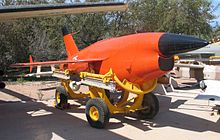
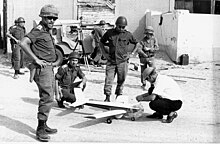
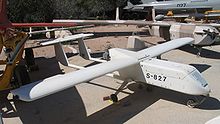
Early drones
The earliest recorded use of an unmanned aerial vehicle for warfighting occurred in July 1849,[28] with a balloon carrier (the precursor to the aircraft carrier)[29] in the first offensive use of air power in naval aviation.[30][31][32] Austrian forces besieging Venice attempted to launch some 200 incendiary balloons at the besieged city. The balloons were launched mainly from land; however, some were also launched from the Austrian ship SMS Vulcano. At least one bomb fell in the city; however, due to the wind changing after launch, most of the balloons missed their target, and some drifted back over Austrian lines and the launching ship Vulcano.[33][34][35]
The Spanish engineer Leonardo Torres Quevedo introduced a radio-based control-system called the Telekino[36] at the Paris Academy of Science in 1903, as a way of testing an airship of his own design without risking human lives.[37][38]
Significant development of drones started in the 1900s, and originally focused on providing practice targets for training military personnel. The earliest attempt at a powered UAV was A. M. Low's "Aerial Target" in 1916.[39] Low confirmed that Geoffrey de Havilland's monoplane was the one that flew under control on 21 March 1917 using his radio system.[40] Following this successful demonstration in the spring of 1917 Low was transferred to develop aircraft controlled fast motor launches D.C.B.s with the Royal Navy in 1918 intended to attack shipping and port installations and he also assisted Wing Commander Brock in preparations for the Zeebrugge Raid. Other British unmanned developments followed, leading to the fleet of over 400 de Havilland 82 Queen Bee aerial targets that went into service in 1935.
Nikola Tesla described a fleet of uncrewed aerial combat vehicles in 1915.[41] These developments also inspired the construction of the Kettering Bug by Charles Kettering from Dayton, Ohio and the Hewitt-Sperry Automatic Airplane – initially meant as an uncrewed plane that would carry an explosive payload to a predetermined target. Development continued during World War I, when the Dayton-Wright Airplane Company invented a pilotless aerial torpedo that would explode at a preset time.[42]
The film star and model-airplane enthusiast Reginald Denny developed the first scaled remote piloted vehicle in 1935.[39]
Soviet researchers experimented with controlling Tupolev TB-1 bombers remotely in the late 1930s.[43]
World War II
In 1940, Denny started the Radioplane Company and more models emerged during World War II – used both to train antiaircraft gunners and to fly attack-missions. Nazi Germany produced and used various UAV aircraft during the war, like the Argus As 292 and the V-1 flying bomb with a jet engine. Fascist Italy developed a specialised drone version of the Savoia-Marchetti SM.79 flown by remote control, although the Armistice with Italy was enacted prior to any operational deployment.[44]
Postwar period
After World War II development continued in vehicles such as the American JB-4 (using television/radio-command guidance), the Australian GAF Jindivik and Teledyne Ryan Firebee I of 1951, while companies like Beechcraft offered their Model 1001 for the U.S. Navy in 1955.[39] Nevertheless, they were little more than remote-controlled airplanes until the Vietnam War. In 1959, the U.S. Air Force, concerned about losing pilots over hostile territory, began planning for the use of uncrewed aircraft.[45] Planning intensified after the Soviet Union shot down a U-2 in 1960. Within days, a highly classified UAV program started under the code name of "Red Wagon".[46] The August 1964 clash in the Tonkin Gulf between naval units of the U.S. and the North Vietnamese Navy initiated America's highly classified UAVs (Ryan Model 147, Ryan AQM-91 Firefly, Lockheed D-21) into their first combat missions of the Vietnam War.[47] When the Chinese government[48] showed photographs of downed U.S. UAVs via Wide World Photos,[49] the official U.S. response was "no comment".
During the War of Attrition (1967–1970) in the Middle East, Israeli intelligence tested the first tactical UAVs installed with reconnaissance cameras, which successfully returned photos from across the Suez Canal. This was the first time that tactical UAVs that could be launched and landed on any short runway (unlike the heavier jet-based UAVs) were developed and tested in battle.[50]
In the 1973 Yom Kippur War, Israel used UAVs as decoys to spur opposing forces into wasting expensive anti-aircraft missiles.[51] After the 1973 Yom Kippur war, a few key people from the team that developed this early UAV joined a small startup company that aimed to develop UAVs into a commercial product, eventually purchased by Tadiran and leading to the development of the first Israeli UAV.[52][pages needed]
In 1973, the U.S. military officially confirmed that they had been using UAVs in Southeast Asia (Vietnam).[53] Over 5,000 U.S. airmen had been killed and over 1,000 more were missing or captured. The USAF 100th Strategic Reconnaissance Wing flew about 3,435 UAV missions during the war[54] at a cost of about 554 UAVs lost to all causes. In the words of USAF General George S. Brown, Commander, Air Force Systems Command, in 1972, "The only reason we need (UAVs) is that we don't want to needlessly expend the man in the cockpit."[55] Later that year, General John C. Meyer, Commander in Chief, Strategic Air Command, stated, "we let the drone do the high-risk flying ... the loss rate is high, but we are willing to risk more of them ...they save lives!"[55]
During the 1973 Yom Kippur War, Soviet-supplied surface-to-air missile-batteries in Egypt and Syria caused heavy damage to Israeli fighter jets. As a result, Israel developed the IAI Scout as the first UAV with real-time surveillance.[56][57][58] The images and radar decoys provided by these UAVs helped Israel to completely neutralize the Syrian air defenses at the start of the 1982 Lebanon War, resulting in no pilots downed.[59] In Israel in 1987, UAVs were first used as proof-of-concept of super-agility, post-stall controlled flight in combat-flight simulations that involved tailless, stealth-technology-based, three-dimensional thrust vectoring flight-control, and jet-steering.[60]
Modern UAVs
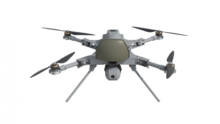
With the maturing and miniaturization of applicable technologies in the 1980s and 1990s, interest in UAVs grew within the higher echelons of the U.S. military. The U.S. funded the CTC or counterterror center within the CIA which sought to fight terrorism with the aid of modernized drone technology.[61] In the 1990s, the U.S. DoD gave a contract to AAI Corporation along with Israeli company Malat. The U.S. Navy bought the AAI Pioneer UAV that AAI and Malat developed jointly. Many of these UAVs saw service in the 1991 Gulf War. UAVs demonstrated the possibility of cheaper, more capable fighting-machines, deployable without risk to aircrews. Initial generations primarily involved surveillance aircraft, but some carried armaments, such as the General Atomics MQ-1 Predator, that launched AGM-114 Hellfire air-to-ground missiles.
CAPECON, a European Union project to develop UAVs,[62] ran from 1 May 2002 to 31 December 2005.[63]
As of 2012[update], the United States Air Force (USAF) employed 7,494 UAVs – almost one in three USAF aircraft.[64][65] The Central Intelligence Agency also operated UAVs.[66] By 2013 at least 50 countries used UAVs. China, Iran, Israel, Pakistan, Turkey, and others designed and built their own varieties. The use of drones has continued to increase.[67] Due to their wide proliferation, no comprehensive list of UAV systems exists.[65][68]
The development of smart technologies and improved electrical-power systems led to a parallel increase in the use of drones for consumer and general aviation activities. As of 2021, quadcopter drones exemplify the widespread popularity of hobby radio-controlled aircraft and toys, however the use of UAVs in commercial and general aviation is limited by a lack of autonomy[clarification needed] and by new regulatory environments which require line-of-sight contact with the pilot.[citation needed]
In 2020, a Kargu 2 drone hunted down and attacked a human target in Libya, according to a report from the UN Security Council's Panel of Experts on Libya, published in March 2021. This may have been the first time an autonomous killer-robot armed with lethal weaponry attacked human beings.[69][70]
Superior drone technology, specifically the Bayraktar TB2, played a role in Azerbaijan's successes in the 2020 Nagorno-Karabakh war against Armenia.[71]

UAVs are also used in NASA missions. The Ingenuity helicopter is an autonomous UAV that operated on Mars from 2021 to 2024. Current the Dragonfly spacecraft is being developed, and is aiming to reach and examine Saturn's moon Titan. Its primary goal is to roam around the surface, expanding the amount of area to be researched previously seen by landers. As a UAV, Dragonfly allows examination of potentially diverse types of soil. The drone is set to launch in 2027, and is estimated to take seven more years to reach the Saturnian system.
Miniaturization is also supporting the development of small UAVs which can be used as individual system or in a fleet offering the possibility to survey large areas, in a relatively small amount of time.[72]
According to a 2024 report from GlobalData, the global military uncrewed aerial systems (UAS) market, which forms a significant part of the UAV industry, is projected to experience a compound annual growth rate of 4.8% over the next decade. This represents a near doubling in market size, from $12.5 billion in 2024 to an estimated $20 billion by 2034.[73]
Design
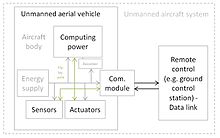
Crewed and uncrewed aircraft of the same type generally have recognizably similar physical components. The main exceptions are the cockpit and environmental control system or life support systems. Some UAVs carry payloads (such as a camera) that weigh considerably less than an adult human, and as a result, can be considerably smaller. Though they carry heavy payloads, weaponized military UAVs are lighter than their crewed counterparts with comparable armaments.
Small civilian UAVs have no life-critical systems, and can thus be built out of lighter but less sturdy materials and shapes, and can use less robustly tested electronic control systems. For small UAVs, the quadcopter design has become popular, though this layout is rarely used for crewed aircraft. Miniaturization means that less-powerful propulsion technologies can be used that are not feasible for crewed aircraft, such as small electric motors and batteries.
Control systems for UAVs are often different from crewed craft. For remote human control, a camera and video link almost always replace the cockpit windows; radio-transmitted digital commands replace physical cockpit controls. Autopilot software is used on both crewed and uncrewed aircraft, with varying feature sets.[74][75][76]
Aircraft configuration
UAVs can be designed in different configurations than manned aircraft both because there is no need for a cockpit and its windows, and there is no need to optimize for human comfort, although some UAVs are adapted from piloted examples, or are designed for optionally piloted modes. Air safety is also less of a critical requirement for unmanned aircraft, allowing the designer greater freedom to experiment. Instead, UAVs are typically designed around their onboard payloads and their ground equipment. These factors have led to a great variety of airframe and motor configurations in UAVs.
For conventional flight the flying wing and blended wing body offer light weight combined with low drag and stealth, and are popular configurations for many use cases. Larger types which carry a variable payload are more likely to feature a distinct fuselage with a tail for stability, control and trim, although the wing configurations in use vary widely.
For uses that require vertical flight or hovering, the tailless quadcopter requires a relatively simple control system and is common for smaller UAVs. Multirotor designs with 6 or more rotors is more common with larger UAVs, where redundancy is prioritized.[77][78]
Propulsion
Traditional internal combustion and jet engines remain in use for drones requiring long range. However, for shorter-range missions electric power has almost entirely taken over. The distance record for a UAV (built from balsa wood and mylar skin) across the North Atlantic Ocean is held by a gasoline model airplane or UAV. Manard Hill "in 2003 when one of his creations flew 1,882 miles across the Atlantic Ocean on less than a gallon of fuel" holds this record.[79]
Besides the traditional piston engine, the Wankel rotary engine is used by some drones. This type offers high power output for lower weight, with quieter and more vibration-free running. Claims have also been made for improved reliability and greater range.[citation needed]
Small drones mostly use lithium-polymer batteries (Li-Po), while some larger vehicles have adopted the hydrogen fuel cell. The energy density of modern Li-Po batteries is far less than gasoline or hydrogen. However electric motors are cheaper, lighter and quieter. Complex multi-engine, multi-propeller installations are under development with the goal of improving aerodynamic and propulsive efficiency. For such complex power installations, Battery elimination circuitry (BEC) may be used to centralize power distribution and minimize heating, under the control of a microcontroller unit (MCU).
Ornithopters – wing propulsion
Flapping-wing ornithopters, imitating birds or insects, have been flown as microUAVs. Their inherent stealth recommends them for spy missions.
Sub-1g microUAVs inspired by flies, albeit using a power tether, have been able to "land" on vertical surfaces.[80] Other projects mimic the flight of beetles and other insects.[81]
Computer control systems

UAV computing capability followed the advances of computing technology, beginning with analog controls and evolving into microcontrollers, then system-on-a-chip (SOC) and single-board computers (SBC).
System hardware for small UAVs is often called the flight controller (FC), flight controller board (FCB) or autopilot. Common UAV-systems control hardware typically incorporate a primary microprocessor, a secondary or failsafe processor, and sensors such as accelerometers, gyroscopes, magnetometers, and barometers into a single module.
Architecture
Sensors
Position and movement sensors give information about the aircraft state. Exteroceptive sensors deal with external information like distance measurements, while exproprioceptive ones correlate internal and external states.[82]
Non-cooperative sensors are able to detect targets autonomously so they are used for separation assurance and collision avoidance.[83]
Degrees of freedom (DOF) refers to both the amount and quality of sensors on board: 6 DOF implies 3-axis gyroscopes and accelerometers (a typical inertial measurement unit – IMU), 9 DOF refers to an IMU plus a compass, 10 DOF adds a barometer and 11 DOF usually adds a GPS receiver.[84]
In addition to the navigation sensors, the UAV (or UAS) can be also equipped with monitoring devices such as: RGB, multispectral, hyper-spectral cameras or LiDAR, which may allow providing specific measurements or observations.[85]
Actuators
UAV actuators include digital electronic speed controllers (which control the RPM of the motors) linked to motors/engines and propellers, servomotors (for planes and helicopters mostly), weapons, payload actuators, LEDs and speakers.
Software
This section needs to be updated. (February 2022) |
The software running on a UAV is called the autopilot or the flight stack. The purpose of the flight stack is to fly the mission autonomously or with remote-pilot input. An autopilot achieves this by obtaining data from sensors, controlling the motors to make progress along a path, and facilitate communications with ground control and mission planning.[86]
UAVs are real-time systems that require high-frequency to changing sensor data. As a result, UAVs rely on single-board computers for their computational needs. Examples of such single-board computers include Raspberry Pis, Beagleboards, etc. shielded with NavIO, PXFMini, etc. or designed from scratch such as NuttX, preemptive-RT Linux, Xenomai, Orocos-Robot Operating System or DDS-ROS 2.0.
Zdroj:https://en.wikipedia.org?pojem=Unmanned_aerial_vehicle
Text je dostupný za podmienok Creative Commons Attribution/Share-Alike License 3.0 Unported; prípadne za ďalších podmienok. Podrobnejšie informácie nájdete na stránke Podmienky použitia.
Antropológia
Aplikované vedy
Bibliometria
Dejiny vedy
Encyklopédie
Filozofia vedy
Forenzné vedy
Humanitné vedy
Knižničná veda
Kryogenika
Kryptológia
Kulturológia
Literárna veda
Medzidisciplinárne oblasti
Metódy kvantitatívnej analýzy
Metavedy
Metodika
Text je dostupný za podmienok Creative
Commons Attribution/Share-Alike License 3.0 Unported; prípadne za ďalších
podmienok.
Podrobnejšie informácie nájdete na stránke Podmienky
použitia.
www.astronomia.sk | www.biologia.sk | www.botanika.sk | www.dejiny.sk | www.economy.sk | www.elektrotechnika.sk | www.estetika.sk | www.farmakologia.sk | www.filozofia.sk | Fyzika | www.futurologia.sk | www.genetika.sk | www.chemia.sk | www.lingvistika.sk | www.politologia.sk | www.psychologia.sk | www.sexuologia.sk | www.sociologia.sk | www.veda.sk I www.zoologia.sk
